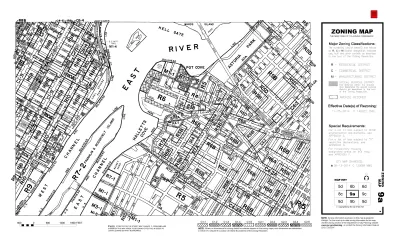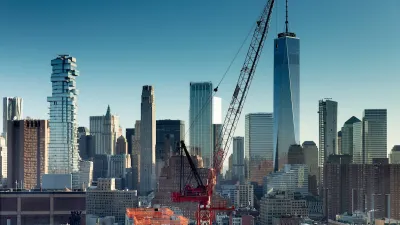According to Seymour Toll's 1969 book, New York City's 1916 zoning code was less a civic-minded project than an attempt to protect elite retail districts from the riff-raff. The ramifications for American zoning at large are significant.

For a short time during the late 1960s, Jake Blumgart writes, "zoning received the attention it deserved as a monumental force shaping the character of many American communities—in large part due to civil rights protests over its exclusionary effects in newer suburbs." Today, renewed debate about urban segregation has cast zoning into the spotlight once again.
In his 1969 book Zoned American, Seymour Toll gives us "an in-depth history of the 1916 New York code, the progenitor of zoning codes nationwide, and the impetus for its creation. The received history of zoning often frames it as a creation of Progressive-era good government planners. But Zoned American shows that the code was actually created as a weapon to defend the narrow self-interest of a small group of prestigious merchants."
In a move that presages problematic zoning later in the century, "wealthy retailers based along Fifth Avenue were the advance guard of zoning in New York. Dubbed the Fifth Avenue Association, they believed their investments would be compromised by the northward advance of the garment industry and the hordes of foreign born workers that accompanied it."
The zoning that emerged from these conditions had specific and recognizable prejudices. It sought to constrain density and height, separating uses to preserve "the northern stretch of Fifth Avenue—and Manhattan more generally—for businesses that catered to the wealthy."
Stephen Smith, well-known as the voice behind @MarketUrbanism on Twitter, remarked, '"There wasn't some grand plan, zoning was taking whatever was there and freezing it [...] Toll convinced me it wasn't really planning, it was just reacting to whatever was already built.'"
FULL STORY: Learning from 'Zoned American'

Alabama: Trump Terminates Settlements for Black Communities Harmed By Raw Sewage
Trump deemed the landmark civil rights agreement “illegal DEI and environmental justice policy.”

Planetizen Federal Action Tracker
A weekly monitor of how Trump’s orders and actions are impacting planners and planning in America.

The 120 Year Old Tiny Home Villages That Sheltered San Francisco’s Earthquake Refugees
More than a century ago, San Francisco mobilized to house thousands of residents displaced by the 1906 earthquake. Could their strategy offer a model for the present?

Ken Jennings Launches Transit Web Series
The Jeopardy champ wants you to ride public transit.

BLM To Rescind Public Lands Rule
The change will downgrade conservation, once again putting federal land at risk for mining and other extractive uses.

Indy Neighborhood Group Builds Temporary Multi-Use Path
Community members, aided in part by funding from the city, repurposed a vehicle lane to create a protected bike and pedestrian path for the summer season.
Urban Design for Planners 1: Software Tools
This six-course series explores essential urban design concepts using open source software and equips planners with the tools they need to participate fully in the urban design process.
Planning for Universal Design
Learn the tools for implementing Universal Design in planning regulations.
Clanton & Associates, Inc.
Jessamine County Fiscal Court
Institute for Housing and Urban Development Studies (IHS)
City of Grandview
Harvard GSD Executive Education
Toledo-Lucas County Plan Commissions
Salt Lake City
NYU Wagner Graduate School of Public Service





























